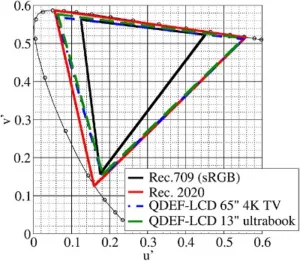SPIE, the International Society of Optics and Photonics, has examined the use of a quantum dot enhancement film (QDEF) to cover more of the Rec.2020 colour gamut with an LCD display.
 Rec.2020 was originally defined for laser projectors – today’s LCD and OLED displays cannot achieve full coverage. SPIE retrofitted two consumer-level LCD displays (a 65″ direct-LED UltraHD TV and a 13″ edge-LED 1920 x 1080 notebook) in order to change this. Two adjustments were made: replacing the original white LEDs in the backlight with blue LEDs and replacing the bottom diffuser (which spreads the LED light across the display) with a QDEF.
Rec.2020 was originally defined for laser projectors – today’s LCD and OLED displays cannot achieve full coverage. SPIE retrofitted two consumer-level LCD displays (a 65″ direct-LED UltraHD TV and a 13″ edge-LED 1920 x 1080 notebook) in order to change this. Two adjustments were made: replacing the original white LEDs in the backlight with blue LEDs and replacing the bottom diffuser (which spreads the LED light across the display) with a QDEF.
Compared to today’s widely-available QDEFs, the SPIE unit has quantum dots (QDs) with different green and red wavelengths: 525nm and 642nm, respectively. Existing QDEF wavelengths are closer to 530nm and 630nm. The power density spectra of the RGB primaries was measured for both displays, with the red spectrum peaking at a significantly higher intensity – necessary due to the low photopic response of the human eye to this colour.
Using this set-up, SPIE achieved 114% NTSC gamut coverage, covering 90% of Rec.2020. The red and green primaries were particularly close to the Rec.2020 standard – within 0.02 in both u’ and v’ chromaticity coordinates. The blue primary was within 0.03. SPIE explains, ‘The blue spectrum…has its primary peak at a blue LED wavelength of close to 445nm and a satellite peak at close to 520nm. This is a result of the green peak of the backlight leaking through the blue colour filter on the liquid crystal panel, limiting the coverage of Rec.2020 to 90%’.
Today’s blue colour filters are mostly designed for Rec.709 and white LEDs, where the yellow peak lies at around 560nm. The leakage of the yellow peak through the blue filter is low enough to be insignificant. However, in Rec.2020 the green peak must lie at much shorter wavelengths to hit the target; this results in more pronounced green leakage through the blue filter, especially for a deeper blue primary target. Using an optimised filter to minimise leakage, 95% Rec.2020 coverage may be possible in an LCD display.
‘QDEF therefore offers a practical and ready-to-implement solution for ultra-high-definition LCD TVs for drastic expansion of the color gamut, to bring true-to-life viewing experiences to end users’, writes SPIE.
1976 CIE diagram of two LCD display demos using QDEF, achieving Rec.709 and Rec.2020. The colour gamut of both demos covers 90% of the Rec.2020 area.![]()
Analyst Comment
The other issue for Rec. 2020 is metamerism. It seems that when lasers are used to achieve the full gamut, the colours are seen differently by different viewers and that could be a real problem. (Are More or Smarter Primaries the Solution to Metameric Failure in Laser Projectors?) (BR)

